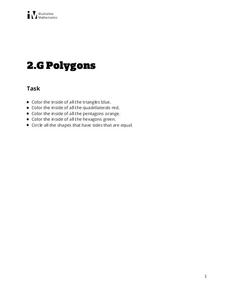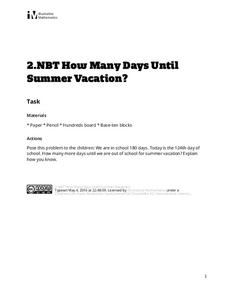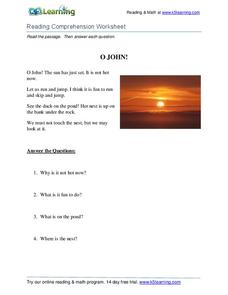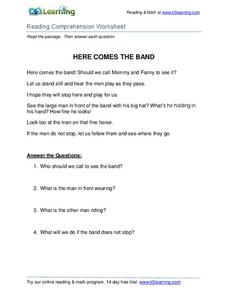Illustrative Mathematics
School Supplies
First graders are tasked to find the amount of money in dollars Pia came to the store with, after she bought five dollars worth of school supplies.
Illustrative Mathematics
Counting Dots in Arrays
Mathematical arrays can represent several different math skills, including counting groups, multiplication, and even area. In this specific task, learners are asked to identify the addition equations that are equal to a 3 x 4 array....
Illustrative Mathematics
Valid Equalities?
True or false: 20 = 10 + 10. The statement is true because two 10s make a 20. These are the types of equations learners must label or false. They must also explain in mathematical terms how they know.
Illustrative Mathematics
Find the Missing Number
First graders are asked to find the missing numbers in subtraction and addition equations. Each missing number is represented with a box and appears as an addend, subtrahend, sum, or difference.
Illustrative Mathematics
Polygons
Identify shapes based on their attributes. Second graders are tasked to color triangles, quadrilaterals, pentagons, and hexagons specific colors. The one thing these shapes have in common? They are all polygons.
Illustrative Mathematics
How Many Days Until Summer Vacation?
On the 124th day of school, young mathematicians are asked to find out how many days are left in the 180-day school year. The teacher version to the task offers several ways the problem can be solved, and can be used to guide instruction...
Illustrative Mathematics
Ordering 3-Digit Numbers
Second graders are asked to order two sets of two- and three-digit numbers from greatest to least, and then least to greatest.
Illustrative Mathematics
Party Favors
Pia is putting stickers into party bags. She starts by putting 10 stickers in each bag, and over the course of a week she adds several bundles of ten stickers to each bag, as well as making more bags. Second graders must find the number...
Teacher's Corner
Hey Batter, Wake Up!
Does jet lag affect a baseball team's performance in games? Read about how a baseball team's chance of winning a game can be affected by traveling over one, two, and three time zones. Readers then respond to five short answer questions...
K5 Learning
Susy Brown
Susy is always at home taking care of her baby sibling. Even when mom is home, Susy has to take care of the baby. Luckily for Susy, she has good friends. After reading about Susy's duties, learners respond to four questions that require...
K5 Learning
Here Ponto
Pronto is a good dog. He saves the narrator's dolls that got into the water and brings them back to the pond's edge. Readers respond to four comprehension questions after reading about Pronto.
K5 Learning
O John!
As the sun sets, what does the narrator see? After reading brief passage, first graders answer four comprehension questions about what they read.
K5 Learning
Here Comes the Band
Can you hear the men playing in the band? What are they playing and where are they going? These are the main ideas of a brief fictional passage.
K5 Learning
In Search of Flowers
There's no love like a mother's adoration for her children. Second graders read a short story about a little girl's discovery of baby birds and their mother before answering four comprehension questions.
K5 Learning
A Big, White Hen
Why wouldn't the chickens cross the brook? Find out in a short reading passage about a mother hen and her babies' daily walk. Second graders answer four comprehension questions after they finish reading the story.
K5 Learning
The Coat
The moral of the story: listen to your parents! A concise reading passage introduces learners to Tom and the consequences of his choice to go out without a coat.
K5 Learning
One of Aesop's Fables
It's one thing to have an idea, but someone has to put it into action! Young pupils read a rendition of Aesop's fable of the mice in the council before answering four questions about details from the text.
K5 Learning
Race Cars
Do you ever get nervous before a big event? A pair of race cars discuss their nerves before tomorrow's race in a reading activity that includes five comprehension questions.
Florida Center for Reading Research
Word Knowledge
Turn skills practice into a game of Bingo! Scholars listen to words and locate their synonyms on their Bingo cards. The first play to fill their card wins.
Heidi Songs
Uncle Sam Hat CVC
American students can show their patriotism by coloring Uncle Sam's hat with red and blue! To do so, they need to identify which words are real and which ones are made up.
K5 Learning
Hide and Seek
Hide and seek is a lot of fun whether you're the hider or the seeker! Second graders read a short passage about a game of hide and seek before answering four reading questions.
K5 Learning
Seven Little Mice
Which days of the week does each mouse find a bun? Is it Monday through Sunday, or Sunday through Saturday? Read a poem about the adventures of the seven mice during the days of the week, followed by four reading comprehension questions.
K5 Learning
Time for Everything
Read a historical fiction poem that explains how there is a time for everything in our daily lives. From sitting to sleeping, pupils read a rhythmic poem and respond to four comprehension questions.
K5 Learning
Changes
You can't unring a bell, but can you unmelt an ice cube? Readers consider reversible and irreversible changes with a short informational reading passage and accompanying comprehension questions.

























